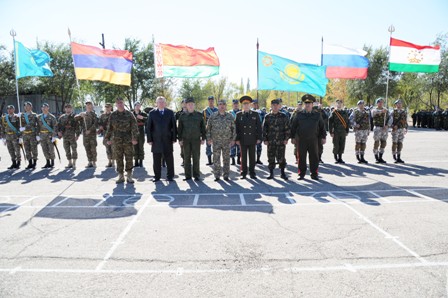
Moscow Promotes Airpower and Peacekeeping on Afghanistan-Linked CSTO Agenda (Part One)
Moscow Promotes Airpower and Peacekeeping on Afghanistan-Linked CSTO Agenda (Part One)
Despite the contraction of the Collective Security Treaty Organization (CSTO)—marked by the collective agreement at its summit in Moscow in December 2012 to interpret Tashkent’s membership “suspension” as a withdrawal—the Kremlin is intensifying its efforts to transform the body ahead of the North Atlantic Treaty Organization’s (NATO) drawdown from Afghanistan in 2014. The CSTO is now in effect reduced to six members: Armenia, Belarus, Kazakhstan, Kyrgyzstan, Russia and Tajikistan. Moscow is pushing three prongs in its strategy—as the CSTO limps on after the de facto exit of Uzbekistan—including placing Afghanistan as an issue on the organization’s agenda, developing joint airpower capabilities and multilateral strengthening peacekeeping capacities. Moscow is making clear progress toward achieving its strategic objectives for the CSTO, linked to exploiting 2014; and this will limit the potential impact of future US security assistance programs in Central Asia (Interfax, April 26).
Paradoxically, with Uzbekistan no longer having any input on the development of the CSTO agenda, dissenting voices are harder to find, especially on the issue of how the CSTO may respond to the imminent departure of NATO combat troops from Afghanistan. Part of Moscow’s positioning to benefit from the NATO exit relates to the future role to be played in Central Asian security by the Kyrgyz Republic. And in relation to advancing Afghanistan as an important theme for CSTO discussion and boosting the organization’s airpower and deployment capabilities, Bishkek is already showing clear signs of where its interests lie. Kyrgyzstan’s Foreign Minister Erlan Abdyldaev addressed the third conference of foreign ministers of the Istanbul Process on Regional Security and Cooperation for a Secure and Stable Afghanistan in Almaty on April 26. Abdyldaev made clear that Bishkek questions the rapid transfer of security responsibilities to the Afghan government and suggested the NATO drawdown might stimulate militant activity in neighboring countries. In other words, he offered a mere facsimile of Russian security policy (Interfax, April 26).
Moscow’s criticism of the North Atlantic Alliance for leaving Afghanistan before the job of stabilization is complete is already well known. However some examples of Russian diplomacy drive home the overall messages, and this is certainly being received in Central Asian capitals and thus influencing the extent to which Afghanistan is becoming a driver of CSTO transformation. Russia’s Foreign Minister Sergei Lavrov used the forum of the NATO-Russia Council (NRC) in Brussels on April 23 to reiterate this perspective on the possible impact of the Alliance withdrawing combat forces from Afghanistan. Although these discussions included the situations in Syria, on the Korean Peninsula and in the Middle East, Afghanistan was also considered. Lavrov said that it was too soon to leave Afghanistan and suggested that NATO must effectively raise the combat capabilities of the Afghan National Army; he also repeated earlier calls for official NATO-CSTO cooperation (Interfax, April 23).
Ahead of the NRC meeting, on April 19, Russian Permanent Representative to NATO Alexander Grushko said that Afghan security forces will prove to be unable to provide adequate protection to the civilian population in the country without international support. “We are concerned about the possible consequences of the accelerated ISAF pullout from that country. Fundamental security problems have not been solved and extremists are calling the tune in many regions. There is a danger of the spread of terrorist activity from Afghanistan to Central Asian countries, which are our allies,” Grushko explained. Thus, Moscow uses the Afghanistan factor to push its agenda through the CSTO and, in turn, to inflate its future security role in Central Asia (Interfax, April 19).
On April 19, CSTO and United Nations experts met in Moscow to discuss border security cooperation and preparations for a CSTO conference on Afghanistan scheduled for Bishkek in October 2013; this meeting occurred in the framework of consultations between the UN Regional Center for Preventative Diplomacy in Central Asia and the CSTO secretariat. CSTO Deputy Secretary General Gennady Nevyglas reported on the decisions of the CSTO Collective Security Council session in December 2012, efforts to strengthen border security cooperation, development of the CSTO military component, and training the of CSTO peacekeepers (Interfax, April 19).
In this wider context of Russian security policy in Central Asia after 2014, the ongoing transformation of the CSTO and efforts to boost joint force capabilities, senior officials in the CSTO disclosed the rather surprising initiative to create a Collective Air Force. A draft agreement on the new Collective Air Force is in place, and will be submitted to the CSTO heads of state by the end of the year. A registry of forces and means to develop this new force has been agreed and will apparently include the “full spectrum of combat aircraft” (Interfax, April 17).
It appears that the backbone of the CSTO Air Force will be drawn from units in Belarus, Kazakhstan and Russia, since the other CSTO members lack airpower, trained pilots, or have insufficient resources to actively contribute (Interfax, April 17). But the reasoning underlying this force structure being considered, as well as plans to greatly expand Russia’s military footprint at the Kant airbase near Bishkek are tied closely to post-2014 Afghanistan and Moscow’s anticipation that the Manas Transit Center will close.


